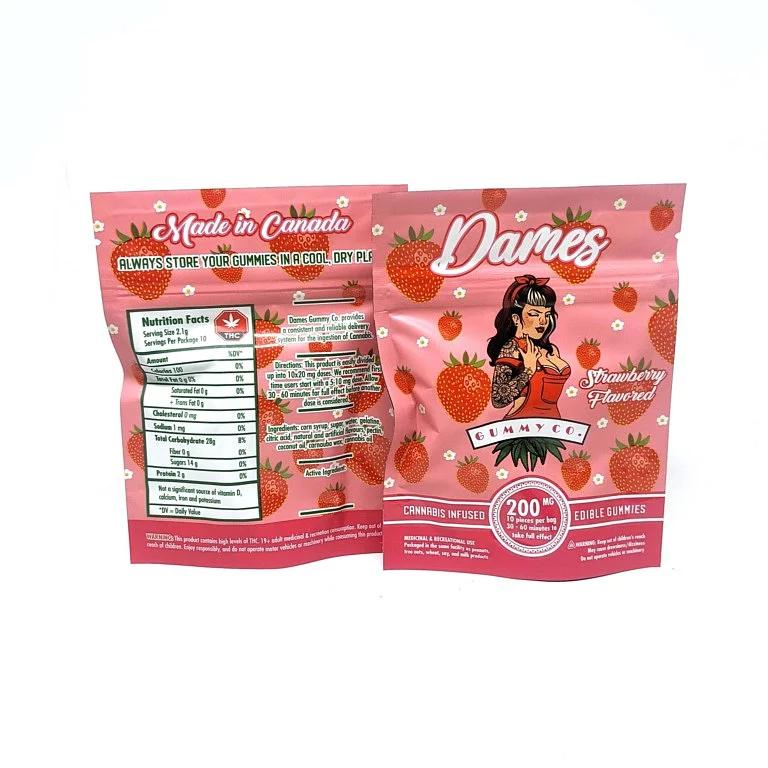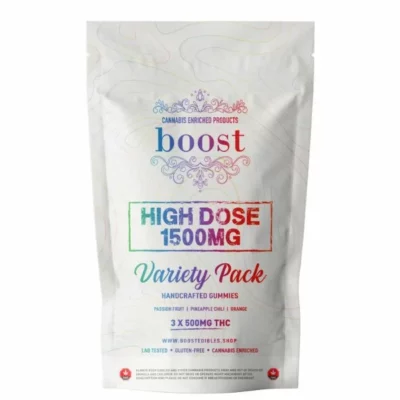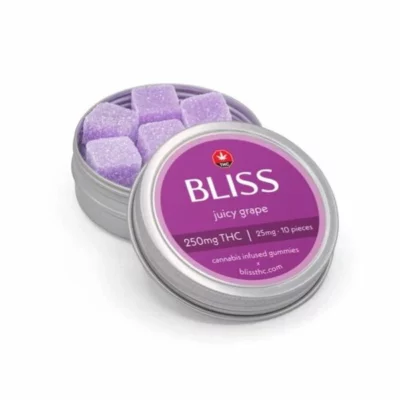Uncategorized
Exploring THC Gummies, Weed Chews, and More for Beginners and Experts
Are you a beginner or an expert looking to explore the world of cannabis edibles? Look no further than the Ultimate Guide to Cannabis Edibles. This comprehensive guide covers everything from THC gummies to weed chews and more. Whether you’re looking to dip your toes into the world of edibles for the first time or you’re a seasoned pro, this guide has something for everyone. Learn about dosing, effects, and different types of edibles to help you make informed decisions about your cannabis consumption. With tips for beginners and experts alike, this guide is a must-read for anyone interested in incorporating edibles into their cannabis routine.
What Are Cannabis Edibles?
Cannabis edibles are ingestible forms of cannabis that include a variety of products such as baked goods, candies, chocolates, and beverages. Among the most popular are THC gummies, which deliver the psychoactive effects of THC in a flavorful, discreet, and easy-to-dose form. THC gummies have gained popularity for their convenience and controlled dosage, making them a favoured choice among both recreational and medicinal users.
THC gummies, specifically, offer a unique experience compared to traditional smoking or vaporizing cannabis. These edibles are infused with THC, the primary psychoactive compound in cannabis, providing a longer-lasting and more intense effect. As THC gummies continue to evolve, they are available in various strengths and flavours to cater to a wide range of preferences. Their popularity underscores the growing trend towards alternative methods of consuming cannabis, with THC gummies leading the charge.
Definition and Types of Edibles
Edibles are consumable products infused with cannabinoids, offering an alternative to smoking or vaping cannabis. Among the variety, THC Gummies stand out for their ease of use, controlled dosage, and discreet nature. THC Gummies are favoured by users seeking a predictable and enjoyable smoke-free experience.
THC Gummies come in various flavours, potencies, and formulations, catering to different preferences and needs. Whether for medicinal purposes or recreational use, THC Gummies provide a convenient and tasteful way to consume THC. Their popularity underscores the growing demand for edibles that combine efficacy with culinary delight.
Benefits of Consuming Cannabis Edibles
Cannabis edibles, particularly THC Gummies, offer a unique blend of benefits for both medicinal and recreational users. These gummies provide a discreet and convenient way to consume THC, making them ideal for those seeking relief from pain, anxiety, or insomnia. The controlled dosage in each gummy ensures a consistent and predictable experience, reducing the risk of overconsumption.
THC Gummies are also known for their long-lasting effects compared to smoking or vaping cannabis. This extended duration makes them an excellent choice for managing chronic conditions. Furthermore, for individuals concerned about the respiratory risks associated with smoking, THC Gummies present a safer alternative, delivering the therapeutic benefits of cannabis without the smoke.
Potency and Dosage Considerations
When it comes to THC gummies, understanding the potency is crucial for both beginners and experienced users. These edibles’ effects largely depend on the amount of THC per serving, making dosage considerations essential. The potency of THC gummies can vary widely, so reading labels and starting with a low dose is advisable.
Determining the correct dosage of THC gummies is critical to achieving the desired effects without discomfort. For newcomers, it’s recommended to begin with THC gummies that have a lower THC content and gradually increase the dosage as tolerance develops. Regular users might opt for THC gummies with higher potency but should still pay attention to dosage to ensure a safe and enjoyable experience.
How Do THC Gummies Differ from Other Edibles?
Gummy THC edibles are a popular choice for those looking to enjoy the benefits of cannabis in a discreet and tasty form. Unlike traditional gummy candies, these edibles contain controlled amounts of THC, which can produce a relaxing and euphoric effect when consumed. One of the main differences between gummy THC edibles and other edibles is the ease of dosing – users can easily track how much they ate and adjust their consumption accordingly. Additionally, gummy THC edibles are legal in a growing number of states, making them more accessible to consumers. The THC concentrations in these gummies can vary, allowing users to choose a potency that suits their needs.
THC vs. CBD in Gummies
When it comes to THC versus CBD in gummies, the main difference lies in their effects on the body. THC is the psychoactive compound found in cannabis that produces a “high,” while CBD is non-psychoactive and more commonly associated with relaxation and pain relief. In gummies, the amount of THC present will determine the level of psychoactive effects, while the CBD content will contribute to the therapeutic benefits. Some people prefer gummies with higher levels of CBD for their calming effects, while others may seek out gummies with a higher THC content for a more recreational experience.
Effects of THC Gummies on the Body
When consuming THC gummies, the effects on the body can vary depending on various factors such as dosage, individual tolerance, and metabolism. THC is the psychoactive compound in cannabis that produces the “high” feeling, while CBD is non-psychoactive and known for its potential therapeutic benefits. The effects of THC gummies typically include relaxation, euphoria, increased appetite, and altered perception of time. However, excessive consumption can lead to side effects such as anxiety, paranoia, and memory impairment. It is important to start with a low dosage and wait for the effects to kick in before consuming more to avoid unpleasant experiences. Additionally, mixing THC gummies with other substances or medications can have unpredictable and harmful effects on the body.
Legal Status of THC Gummies in Various States
THC gummies have varying legal statuses in different states across the US. Some states have legalized recreational use of THC gummies, while others only allow them for medicinal purposes. In states where recreational use is legal, the sale and consumption of THC gummies are regulated to ensure safety and quality control. It’s important to note that CBD gummies, which do not contain THC, are legal in all 50 states. The effects of consuming THC gummies can vary depending on the individual, with the peak effect typically occurring within 2-4 hours after consumption. Consumers must be aware of the regulations in their state regarding the use of THC gummies to avoid any legal consequences.
Are Cannabis Edibles Safer Than Smoking?
When comparing cannabis edibles to smoking, many argue that edibles are safer due to the fact that they do not involve inhaling smoke into the lungs. By ingesting cannabis in the form of edibles, users avoid the potential risks associated with smoking, such as respiratory issues. Additionally, edibles provide a more controlled and consistent dosage, which can be beneficial for those who are new to cannabis or looking for a more predictable experience. It’s important to note that the effects of edibles can take longer to kick in compared to smoking, but they also tend to last longer. Furthermore, THC and CBD levels in edibles can be more accurately measured and labeled, reducing the likelihood of overconsumption.
Risks and Side Effects of Edibles
When consuming edibles, there are several risks and side effects to be aware of. One of the most common risks is accidentally consuming too much THC, which can lead to feelings of anxiety, paranoia, and even hallucinations. It can also be difficult to gauge the potency of edibles, as they can take longer to take effect compared to smoking or vaping. This delayed onset can result in people consuming more than intended, leading to potential overdose symptoms such as rapid heart rate, nausea, and vomiting.
THC Poisoning and Ways to Avoid It
THC poisoning can occur when an individual consumes too much tetrahydrocannabinol, the psychoactive component in marijuana. Symptoms can include anxiety, paranoia, hallucinations, and increased heart rate. It is important to be mindful of THC levels when using cannabis products, especially edibles, which can have high concentrations of THC. To avoid THC poisoning, start with a low dose and wait for the effects to kick in before consuming more. Additionally, always purchase cannabis products from reputable sources to ensure accurate dosing. Remember to store cannabis products out of reach of children and pets to prevent accidental ingestion.
Comparing High Strength Edibles vs. Low Strength
When it comes to cannabis edibles, the strength of the product can make a big difference in the overall experience. High-strength edibles typically contain a higher concentration of THC, the psychoactive component in cannabis, which can result in a more intense and long-lasting high. On the other hand, low-strength edibles have a lower THC content, which may be more suitable for those who are new to edibles or prefer a milder effect. The potency of the edibles can also affect the duration of the high, with high-strength edibles often leading to a longer and more pronounced experience. It’s important to consider your tolerance and desired effects when choosing between high-strength and low-strength edibles.
How Can You Infuse Cannabis into Edibles at Home?
Infusing cannabis into edibles at home can be a fun and creative way to enjoy the benefits of marijuana in a delicious treat. One popular method is to first decarboxylate the cannabis by baking it in the oven at a low temperature. Once described, the cannabis can be infused into butter or oil, which can then be used in a variety of recipes. When infusing cannabis into edibles, it’s important to calculate the potency per serving to ensure a consistent and enjoyable experience. This can be done by determining the total amount of THC in the infused butter or oil and dividing it by the number of servings in the recipe.
Methods of Infusing Cannabis into Cooking Oil or Butter
Decarboxylation: Before infusing cannabis into cooking oil or butter, it is important first to decarboxylate the cannabis to activate the THC and CBD compounds. This involves heating the cannabis at a low temperature in the oven to convert the THCA and CBDA into THC and CBD.
Infusion: There are various methods for infusing cannabis into cooking oil or butter, including using a slow cooker, double boiler, or stovetop. The key is to heat the oil or butter with the decarboxylated cannabis for a prolonged period to allow for the cannabinoids to be extracted and infused into the oil or butter.
Straining: Once the infusion process is complete, it is important to strain the oil or butter to remove any plant material. This can be done using a cheesecloth or fine mesh strainer to ensure a smooth and clean infusion.
Storage: The infused cooking oil or butter can be stored in an airtight container in a cool, dark place for future use in various recipes. It is important to label the container clearly to avoid accidental consumption.
Best Practices for Dosing Cannabis in Homemade Edibles
When it comes to dosing cannabis in homemade edibles, there are several best practices to keep in mind. Firstly, it’s important to decarboxylate your cannabis before using it in recipes to activate the THC. This can be done by baking the cannabis in the oven at a low temperature for a certain amount of time. Secondly, it’s recommended to start with a small amount of cannabutter or canna-oil in your recipe and gradually increase the dosage as needed. It’s also crucial to properly mix the cannabis-infused ingredient into your recipe to ensure even distribution. Lastly, always monitor the potency of your edibles by starting with a small portion and waiting a few hours before consuming more to gauge the effects.
Recipes for Making THC-Infused Edibles
Are you interested in learning how to make THC-infused edibles? Making your THC-infused treats can be a fun and creative way to enjoy the effects of cannabis. Before you begin, it’s important to gather all the necessary ingredients and equipment. Some popular THC-infused recipes include brownies, cookies, gummies, and even savory dishes like pasta sauces. Each recipe will require a specific amount of THC-infused oil or butter, so be sure to follow the instructions carefully to ensure the right dosage. Once you’ve assembled everything you need, it’s time to start cooking and experimenting with different flavors and techniques to create delicious THC-infused edibles that suit your tastebuds.
What Should Beginners Know Before Trying Cannabis Edibles?
Beginners should be aware that cannabis edibles can have a much stronger effect than smoking or vaping due to different methods of consumption. It is important to start with a low dose, as the effects can take longer to kick in and last much longer than inhaling. It is also crucial to be patient and not overindulge, as the effects can be overwhelming and unpleasant if too much is consumed. Beginners should choose a comfortable and safe environment to try edibles and have a trusted friend with them in case they need assistance. It is recommended to wait at least 2 hours before consuming more to allow the full effects to be felt.
Guidelines for Beginners on Choosing Edibles
When it comes to choosing edibles for beginners, there are a few important guidelines to keep in mind. First and foremost, it’s essential to start with a low dose of THC, the active ingredient in cannabis, to avoid any unpleasant experiences. It’s also important to look for products that are clearly labeled with the THC content so you know exactly how much you’re consuming. Additionally, opt for edibles that are made with high-quality ingredients and from reputable brands to ensure a safe and enjoyable experience. Lastly, always wait at least an hour before consuming more, as the effects of edibles can take longer to kick in compared to smoking or vaping.
Common Mistakes to Avoid When Trying Edibles
One of the most common mistakes when trying edibles is consuming too much too quickly. It’s important to start with a low dose and wait at least an hour before deciding to take more. Another mistake is not properly reading the labeling on the edible product. Make sure to understand the THC content and serving size to avoid overconsumption. Additionally, many people make the error of not being patient enough with edibles. They may not feel the effects right away, leading them to consume more than necessary. It’s crucial to wait for the full onset of effects before deciding to take more.
Understanding the Delayed Onset of Edibles and Its Effects
One of the key reasons why edibles are different from smoking cannabis is the delayed onset of effects. Consuming edibles can take anywhere from 30 minutes to 2 hours before the effects are felt. This is because the cannabinoids in edibles have to be metabolized by the liver before they can enter the bloodstream. This delayed onset can catch some people off guard if they are not aware of it, leading to consuming more than necessary and experiencing uncomfortable side effects.
The slow release of cannabinoids into the bloodstream also means that the effects of edibles can last longer compared to smoking. Individuals need to be patient and wait for the full effects to kick in before consuming more edibles to avoid overconsumption.




